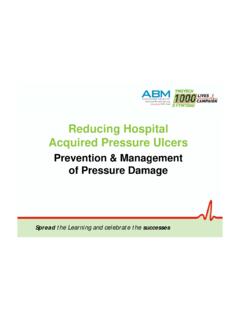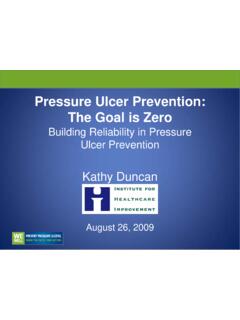Transcription of Reducing hospital acquired pressure ulcers in intensive care
1 BMJ Quality Improvement Reports 2015; doi: Reducing hospital acquired pressure ulcers in intensive careEmma Cullen GillAl Ain hospital , Al Ain, Abu Dhabi, UAE. AbstractPressure ulcers are a definite problem in our health care system and are growing in numbers. Unfortunately, it is usually the most weak andvulnerable of our culture that faces these complications, causing the patient and their families discomfort, anguish, and economic hardship dueto their expensive collected by the tissue viability department showed high incidence of hospital acquire pressure ulcers in the intensive care unit in March2013.
2 An action plan was initiated and implemented by the tissue viability team, senior nursing management, pressure ulcer prevention (PUP)team and respiratory therapists (RT s) within the ICU. Our objective was to reduce hospital acquired pressure ulcers in the intensive care unitusing the plan, do, check, act quality improvement hospital acquired pressure ulcer incidence data werecollected and recorded by the tissue viability departmentcommencing in January 2013. These numbers included hospitaland home acquired pressure ulcers . The incidence rate fluctuatedfrom a month to month basis and problem areas were identified andnoted.
3 The month of March 2013 was noted to be very high, with atotal incidence rate of 16. Of this number, 12 were hospital acquiredpressure ulcers , with six of these occurring in the intensive care unit(ICU).An in depth root cause analysis (RCA) was also carried out by theICU PUP team which showed that although all six ICU patients hadcommon factors such as being intubated and ventilated and oninotropes, they were also all on complete bed rest or had veryrestrcited mobility. Three patients also suffered from incontinence does not cause pressure ulcers , although itdoes predispose the patient to the development of pressure ulcersdue to the damage of the skins mantle by the corrosive effects ofurine and faeces.
4 Another factor raised was the number of patientswith medical device related pressure ulcers , caused by oxygenbilevel positive airway pressure (BIPAP)/continuous positive airwaypressure (CPAP) ulcers are a real and definite problem in our medicalsystem.[1] Regardless of all our new equipment and know how, pressure ulcers are not on a downward trend.[2] pressure ulcersare growing in incidence,[3] and it is usually the most vulnerable,elderly, and weak of our society who face these complications.[4] pressure ulcers cause the patient pain and misery and areexpensive to treat.[5] They can also be a aspect in patients mortality rates.
5 [6] High incidences of pressure ulcers in anorganization may imply a diminished quality of care.[4]A pressure ulcer is defined as a localised injury to the skin and/orunderlying tissue usually over a bony prominence, as a result ofpressure, or pressure in combination with shear .[7] They are sixclasses of pressure ulcer , grades 1-4, unstageable and deep tissueinjury.[7]Figures show that despite an increase in technology and medicaladvances, the incidence and cost of hospital acquired pressureulcer management are extensive and increasing.[8] The cost oftreating these mainly preventable occurrences in the UnitedKingdom (UK) fluctuates from billion annually or 4% ofthe total National Health Service (NHS) expenditure.
6 [9] In one Irishstudy, the cost of treating a patient with several Grade 4 pressureulcers over a five month period to total healing was 119,000 [10].However, a successful outcome is not always likely ascomplications often arise in the grade 3 and 4 stage pressureulcers, causing infection and in some cases even death.[11] pressure ulcers are a mostly avoidable incidence.[12] Researchhas shown that when nursing staff are educated andknowledgeable on pressure ulcer prevention, nursing practice canthen change and improve[13] According to Land,[14] pressure ulcerprevention is such a vital recurring aspect of nursing care that manystaff fail to concede its importance and consequence in maintainingstandards of care.
7 Conversely, evidence has shown that patientacuity and nursing assignments have amplified in the last 30years.[15] The challenges of this demanding environment impactson nursing staffs ability to practice quality care, show support, andact as a good role model for newly qualified or junior staff.[16]There is a misunderstanding that pressure ulcers are a result ofpoor nursing care. While quality of care does play a role, pressureulcers are a complicated, multifactorial disease that is oftendisregarded by medical staff.[17] pressure ulcers are complexwounds requiring an overabundance of skills and knowledge tomanage and care for.
8 [12] There are many policies and guidelineson pressure ulcer prevention and management.[7,19] Regrettably,studies have shown that many qualified staff nurses do not adhere Page 1 of 5 2015, Published by the BMJ Publishing Group Limited. For permission to use (where not already granted under a licence) please go to on October 16, 2019 by guest. Protected by Qual Improv Report: first published as on 9 June 2015. Downloaded from to these guidelines or evidence based practice, leading toinsufficient pressure ulcer prevention practice.[20]According to Dealey,[21] a prevalence is described as a "snapshot"and is an effective tool for identifying where the pressure ulcersoccurred, the grade of pressure ulcer , and the site of prevalence acts as a reference point measurement and can beused to monitor developments or the effectiveness of a preventionprogramme.
9 An incidence is a measure of the risk of developingsome new condition within a specified period of time.[21] One studyshowed a prevalence of 13% in a short stay ICU whilst it increasedto 42% for a long stay unit.[22] Incidences of pressure ulcers inICU s vary between 10-41%.[22] hospital acquired pressure ulcers have been acknowledged as themost recurrent occurring nurse sensitive indicator amonghospitalised patients.[23] The Agency for Healthcare Research andQuality (AHRQ), found that patients with a pressure ulcer stayed inhospital three times longer, than patients without a pressureulcer.[24] One study suggested that employing experiencedregistered nurses can improve the quality of care a patientreceives.
10 [25] In their study they examined the National Database ofNursing Quality Indicators (NDNQI) and found that having a higherpercentage of experienced registered nurses in a clinical arearesulted in fewer patient falls and a lower hospital acquiredpressure ulcer prevalence rate.[25]Baseline measurementMonthly incidence reports of all pressure ulcers were reported bynursing staff through a hospital patient safety net (PSN) system andcollected and verified by the tissue viability team. Although homeacquired pressure ulcers were also reported, our priority was inreducing and preventing hospital acquired pressure 2013 incidence data showed a total of 16 patients withpressure ulcers .





